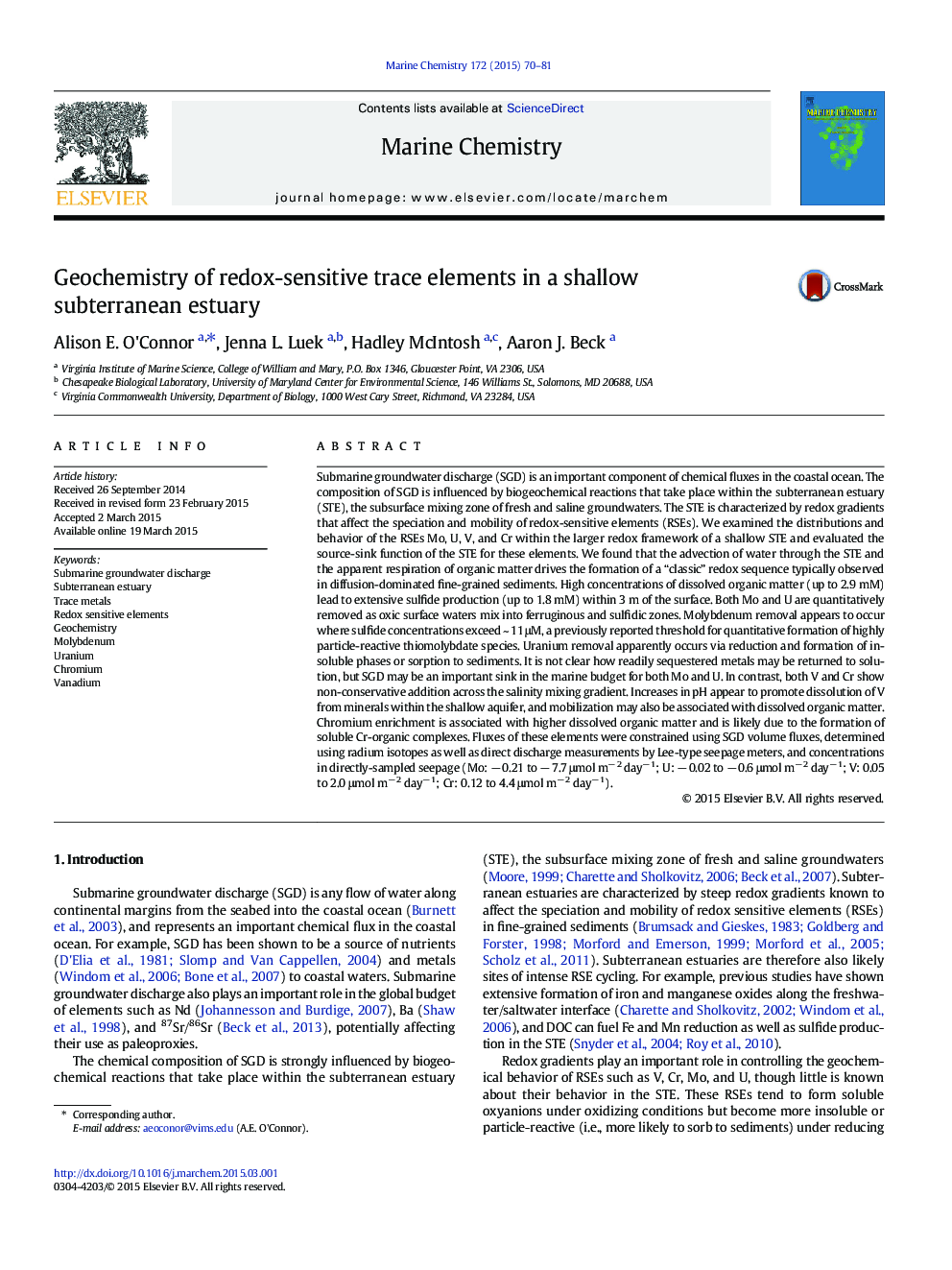| کد مقاله | کد نشریه | سال انتشار | مقاله انگلیسی | نسخه تمام متن |
|---|---|---|---|---|
| 7699370 | 1496663 | 2015 | 12 صفحه PDF | دانلود رایگان |
عنوان انگلیسی مقاله ISI
Geochemistry of redox-sensitive trace elements in a shallow subterranean estuary
ترجمه فارسی عنوان
ژئوشیمیایی عناصر ردیابی حساس به ردکس در یک سطح زیرزمینی کم عمق
دانلود مقاله + سفارش ترجمه
دانلود مقاله ISI انگلیسی
رایگان برای ایرانیان
کلمات کلیدی
تخلیه آب زیرزمینی آبهای زیرزمینی، سواحل زیرزمینی، فلزات کمیاب، عناصر حساس رندکس، ژئوشیمی، مولیبدن، اورانیوم، کروم، وانادیوم،
موضوعات مرتبط
مهندسی و علوم پایه
شیمی
شیمی (عمومی)
چکیده انگلیسی
Submarine groundwater discharge (SGD) is an important component of chemical fluxes in the coastal ocean. The composition of SGD is influenced by biogeochemical reactions that take place within the subterranean estuary (STE), the subsurface mixing zone of fresh and saline groundwaters. The STE is characterized by redox gradients that affect the speciation and mobility of redox-sensitive elements (RSEs). We examined the distributions and behavior of the RSEs Mo, U, V, and Cr within the larger redox framework of a shallow STE and evaluated the source-sink function of the STE for these elements. We found that the advection of water through the STE and the apparent respiration of organic matter drives the formation of a “classic” redox sequence typically observed in diffusion-dominated fine-grained sediments. High concentrations of dissolved organic matter (up to 2.9 mM) lead to extensive sulfide production (up to 1.8 mM) within 3 m of the surface. Both Mo and U are quantitatively removed as oxic surface waters mix into ferruginous and sulfidic zones. Molybdenum removal appears to occur where sulfide concentrations exceed ~ 11 μM, a previously reported threshold for quantitative formation of highly particle-reactive thiomolybdate species. Uranium removal apparently occurs via reduction and formation of insoluble phases or sorption to sediments. It is not clear how readily sequestered metals may be returned to solution, but SGD may be an important sink in the marine budget for both Mo and U. In contrast, both V and Cr show non-conservative addition across the salinity mixing gradient. Increases in pH appear to promote dissolution of V from minerals within the shallow aquifer, and mobilization may also be associated with dissolved organic matter. Chromium enrichment is associated with higher dissolved organic matter and is likely due to the formation of soluble Cr-organic complexes. Fluxes of these elements were constrained using SGD volume fluxes, determined using radium isotopes as well as direct discharge measurements by Lee-type seepage meters, and concentrations in directly-sampled seepage (Mo: â 0.21 to â 7.7 μmol mâ 2 dayâ 1; U: â 0.02 to â 0.6 μmol mâ 2 dayâ 1; V: 0.05 to 2.0 μmol mâ 2 dayâ 1; Cr: 0.12 to 4.4 μmol mâ 2 dayâ 1).
ناشر
Database: Elsevier - ScienceDirect (ساینس دایرکت)
Journal: Marine Chemistry - Volume 172, 20 May 2015, Pages 70-81
Journal: Marine Chemistry - Volume 172, 20 May 2015, Pages 70-81
نویسندگان
Alison E. O'Connor, Jenna L. Luek, Hadley McIntosh, Aaron J. Beck,
